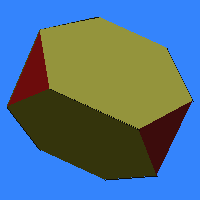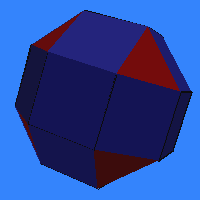 These
solids were described by Archimedes, although his original writings on
the topic are lost and only known of second-hand. All but one of
these polyhedra were gradually rediscovered during the Renaissance by various
artists, and Kepler finally
reconstructed the entire set in 1619.
These
solids were described by Archimedes, although his original writings on
the topic are lost and only known of second-hand. All but one of
these polyhedra were gradually rediscovered during the Renaissance by various
artists, and Kepler finally
reconstructed the entire set in 1619.
A key characteristic of the Archimedean solids is that each face is a regular polygon, and around every vertex, the same polygons appear in the same sequence, e.g., hexagon-hexagon-triangle in the truncated tetrahedron, shown above. Two or more different polygons appear in each of the Archimedean solids, unlike the Platonic solids which each contain only a single type of polygon. The polyhedron is required to be convex.
Here are the possibilities as to what can appear at a vertex. The notation (3, 4, 3, 4) means each vertex contains a triangle, a square, a triangle, and a square, in that cyclic order.
- (3, 4, 3, 4) cuboctahedron
- (3, 5, 3, 5) icosidodecahedron
- (3, 6, 6) truncated tetrahedron
- (4, 6, 6) truncated octahedron
- (3, 8, 8) truncated cube
- (5, 6, 6) truncated icosahedron
- (3, 10, 10) truncated dodecahedron
- (3, 4, 4, 4) rhombicuboctahedron, sometimes called the small rhombicuboctahedron
- (4, 6, 8) truncated cuboctahedron, sometimes called the great rhombicuboctahedron
- (3, 4, 5, 4) rhombicosidodecahedron, sometimes called the small rhombicosidodecahedron
- (4, 6, 10) truncated icosidodecahedron, sometimes called the great rhombicosidodecahedron
- (3, 3, 3, 3, 4) snub cube, better called the snub cuboctahedron
- (3, 3, 3, 3, 5) snub dodecahedron, better called the snub icosidodecahedron
Although the accepted polyhedron names are less than ideal, there is a certain logic to the names above. (They are adapted from Kepler's Latin terminology.) The term snub refers to a process of surrounding each polygon with a border of triangles as a way of deriving for example the snub cube from the cube. The term truncated refers to the process of cutting off corners. Compare, for example, the cube and the truncated cube. Truncation adds a new face for each previously existing vertex, and replaces n-sided polygons with 2n-sided ones, e.g., octagons instead of squares.
There is also another class of polyhedra in which the same regular polygons appear at each vertex: the prisms and antiprisms, which have vertex types (4, 4, n) and (3, 3, 3, n) respectively. But as these form two infinite series, they can not be all listed, and so are described as a separate group.
 Exercise:
Just saying that the same regular polygons appear in the same sequence
at each vertex is not a sufficient definition of these polyhedra. The Archimedean
solid (shown at right) in which three squares and a triangle meet at each
vertex is the rhombicuboctahedron.
Look at it, and then imagine another, similar, convex solid with three
squares and an equilateral triangle at each vertex. Figure out what it
must be before looking at the answer.
Exercise:
Just saying that the same regular polygons appear in the same sequence
at each vertex is not a sufficient definition of these polyhedra. The Archimedean
solid (shown at right) in which three squares and a triangle meet at each
vertex is the rhombicuboctahedron.
Look at it, and then imagine another, similar, convex solid with three
squares and an equilateral triangle at each vertex. Figure out what it
must be before looking at the answer.
Answer: Read about the pseudo-rhombicuboctahedron.
Exercise: The first two entries in the list above, the cuboctahedron and the icosidodecahedron, have certain special properties. What do you notice about their edges ?
Answer: They belong to a
special class of polyhedra.
A more precise definition of these Archimedean solids would be that that are convex polyhedra composed of regular polygons such that every vertex is equivalent. By "equivalent" is meant that one can choose any two vertices, say x and y, and there is some way to rotate or reflect the entire polyhedron so that it appears unchanged as a whole, yet vertex x moved to the position of vertex y. Kepler realized that with a definition of this sort, that there are many more possibilities: the prisms and antiprisms.